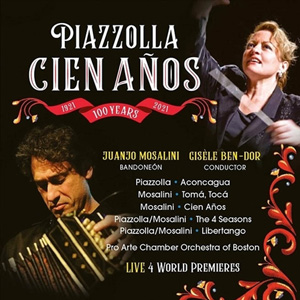The disc is obviously a labor of love. Mosalini is the perfect soloist, and Gisèle Ben-Dor’s leadership is unsurpassed, especially in the articulation of the emotional shading. The orchestra, especially the string soloists, play as if they were in Buenos Aires. Sound quality is also very fine, especially for a concert recording. Tango devotees will find this programme a worthy tribute to Piazzolla. Those interested in exploring the tango might as well start at the top, with this disc.
-William Kreindler
 One might not think of Boston as a center of the tango, but the Pro Arte Chamber Orchestra under Gisèle Ben-Dor, its former conductor and now Conductor Emerita, have programmed the dance. Astor Piazzolla created Nuevo Tango – meant for listening, not dancing – and is the best-known advocate of Tango music. Works on this disc, which commemorates his centenary, were either written for bandoneón and orchestra or arranged by Juanjo Mosalini, perhaps today’s foremost soloist on the instrument. This accordion with buttons rather than keys is a fixture of Argentinian popular music.
One might not think of Boston as a center of the tango, but the Pro Arte Chamber Orchestra under Gisèle Ben-Dor, its former conductor and now Conductor Emerita, have programmed the dance. Astor Piazzolla created Nuevo Tango – meant for listening, not dancing – and is the best-known advocate of Tango music. Works on this disc, which commemorates his centenary, were either written for bandoneón and orchestra or arranged by Juanjo Mosalini, perhaps today’s foremost soloist on the instrument. This accordion with buttons rather than keys is a fixture of Argentinian popular music.
Between 1965 and 1970, Piazzolla wrote four pieces which describe Buenos Aires in different seasons of the year. Known together as Estaciones Porteñas, they are not a suite but Piazzolla’s quintet or octet would sometimes play them together. In 1996-1998, Russian composer Leonid Desyatnikov arranged them as a suite for violin and orchestra. Mosalini’s new arrangement for bandoneón and orchestra was made at Ben-Dor’s request. He also linked the movements and edited them into a sort of symphonic poem. Its elements range from a big-city motif, not unlike that in Vaughan Williams’s London Symphony, through the typical nostalgic Tango, to descriptions of the actual seasons. The work continues with depicting the busy streets of Buenos Aires before the final apotheosis of the city. I found this music evocative and truly affecting.
Mosalini wrote the tango Cien Años (100 years) in memory of his grandfather. This arrangement, also made at Ben-Dor’s request, is a centenary homage to Piazzolla. It starts with an introduction fiull of pathos, becomes more energetic, and ends in sadness – a fine tribute to both men. Tomá, Tocá (take it, play it) is very original, notably in its use of solo strings. Mosalini has also arranged Piazzolla’s well-known Libertango, written during one the master’s lengthy stays in Europe. Classical music and jazz both deeply influenced Piazzolla. This piece’s propulsiveness harks back to Baroque music.
Aconcagua is the highest mountain in the Americas. Piazzolla’s publisher bestowed the name on his 1979 Concerto for Bandoneón and Orchestra: he considered it the pinnacle of Piazzolla’s output. It is scored for strings, piano, harp, tympani and percussion. The vigorous first movement, almost a double concerto for bandoneón and piano, may bring Stravinsky to mind. The typical Tango nostalgia is ever-present, and is developed in classical fashion. All three movements are expertly scored. The second begins with a haunting cadenza for the soloist, joined by strings as the cadenza material is developed. The last movement echoes the first in excitement; hints of Stravinsky or perhaps Les Six are present again. After a heartfelt slower section, the movement becomes intense before ending abruptly.
The disc is obviously a labor of love. Mosalini is the perfect soloist, and Gisèle Ben-Dor’s leadership is unsurpassed, especially in the articulation of the emotional shading. The orchestra, especially the string soloists, play as if they were in Buenos Aires. Sound quality is also very fine, especially for a concert recording. Tango devotees will find this programme a worthy tribute to Piazzolla. Those interested in exploring the tango might as well start at the top, with this disc.
